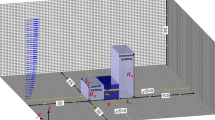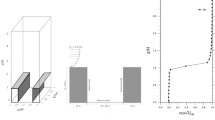Abstract
Using a computational fluid dynamics (CFD) model, the effects of street-bottom and building-roof heating on flow in three-dimensional street canyons are investigated. The building and street-canyon aspect ratios are one. In the presence of street-bottom heating, as the street-bottom heating intensity increases, the mean kinetic energy increases in the spanwise street canyon formed by the upwind and downwind buildings but decreases in the lower region of the streamwise street canyon. The increase in momentum due to buoyancy force intensifies mechanically induced flow in the spanwise street canyon. The vorticity in the spanwise street canyon strengthens. The temperature increase is not large because relatively cold above-roof-level air comes into the spanwise street canyon. In the presence of both street-bottom and building-roof heating, the mean kinetic energy rather decreases in the spanwise street canyon. This is caused by the decrease in horizontal flow speed at the roof level, which results in the weakening of the mean flow circulation in the spanwise street canyon. It is found that the vorticity in the spanwise street canyon weakens. The temperature increase is relatively large compared with that in the street-bottom heating case, because relatively warm above-roof-level air comes into the spanwise street canyon.
Similar content being viewed by others
References
Baik, J.-J., and J.-J. Kim, 1999: A numerical study of flow and pollutant dispersion characteristics in urban street canyons. J. Appl. Meteor., 38, 1576–1589.
Baik, J.-J., Y.-S. Kang, and J.-J. Kim, 2007a: Modeling reactive pollutant dispersion in an urban street canyon. Atmos. Environ., 41, 934–949.
Baik, J.-J., Y.-H. Kim, J.-J. Kim, and J.-Y. Han, 2007b: Effects of boundary-layer stability on urban heat island-induced circulation. Theor. Appl. Climatol., 89, 73–81.
Hunter, L. J., G.T. Johnson, and I.D. Watson, 1992: An investigation of three-dimensional characteristics of flow regimes within the urban canyon. Atmos. Environ., 26B, 425–432.
Kim, J.-J., 2007: The effects of obstacle aspect ratio on surrounding flows. Atmosphere, 17, 381–391. (in Korean with English abstract)
Kim, J.-J., and J.-J. Baik, 1999: A numerical study of thermal effects on flow and pollutant dispersion in urban street canyons. J. Appl. Meteor., 38, 1249–1261.
Kim, J.-J., and J.-J. Baik, 2001: Urban street-canyon flows with bottom heating. Atmos. Environ., 35, 3395–3404.
Kim, J.-J., and J.-J. Baik, 2004: A numerical study of the effects of ambient wind direction on flow and dispersion in urban street canyons using the RNG k-ɛ turbulence model. Atmos. Environ., 38, 3039–3048.
Kim, J.-J., and J.-J. Baik, 2005: Physical experiments to investigate the effects of street bottom heating and inflow turbulence on urban street-canyon flow. Adv. Atmos. Sci., 22, 230–237.
Kovar-Panskus, A., L. Moulinneuf, E. Savory, A. Abdelqari, J.-F. Sini, J.-M. Posant, A. Robins, and N. Toy, 2002: A wind tunnel investigation of the influence of solar-induced wall-heating on the flow regime within a simulated urban street canyon. Water, Air, and Soil Pollution, 2, 555–571.
Niachou, K., I. Livada, and M. Santamouris, 2005: A study of temperature and wind distribution inside two urban street canyons in Athens. International Conference on Passive and Low Energy Cooling for the Built Environment, Santorini, Greece, 125–131.
Richards, K., M. Schatzmann, and B. Leitl, 2006: Wind tunnel experiments modelling the thermal effects within the vicinity of a single block building with leeward wall heating. J. Wind Eng. Ind. Aerod., 94, 621–636.
Rozoff, C. M., W. R. Cotton, and J. O. Adegoke, 2003: Simulation of St. Louis, Missouri, land use impacts on thunderstorms. J. Appl. Meteor., 42, 716–738.
Sini, J.-F., S. Anquetin, and P. G. Mestayer, 1996: Pollutant dispersion and thermal effects in urban street canyons. Atmos. Environ., 30, 2659–2677.
Uehara, K., S. Murakami, S. Oikawa, and S. Wakamatsu, 2000: Wind tunnel experiments on how thermal stratification affects flow in and above urban street canyons. Atmos. Environ., 34, 1553–1562.
Versteeg, H. K., and W. Malalasekera, 1995: An Introduction to Computational Fluid Dynamics: The Finite Volume Method. Longman, Malaysia, 198–203.
Wallace, J. M., and P. V. Hobbs, 2006: Atmospheric Science: An Introductory Survey. Academic Press, Oxford, 411pp.
Xie, X., C.-H. Liu, D. Y. C. Leung, and M. K. H. Leung, 2006: Characteristics of air exchange in a street canyon with ground heating. Atmos. Environ., 40, 6396–6409.
Xie, X., C.-H. Liu, and D. Y. C. Leung, 2007: Impact of building facades and ground heating on wind flow and pollutant transport in street canyons. Atmos. Environ., 41, 9030–9049.
Author information
Authors and Affiliations
Corresponding author
Rights and permissions
About this article
Cite this article
Kim, JJ., Baik, JJ. Effects of street-bottom and building-roof heating on flow in three-dimensional street canyons. Adv. Atmos. Sci. 27, 513–527 (2010). https://doi.org/10.1007/s00376-009-9095-2
Received:
Revised:
Published:
Issue Date:
DOI: https://doi.org/10.1007/s00376-009-9095-2




